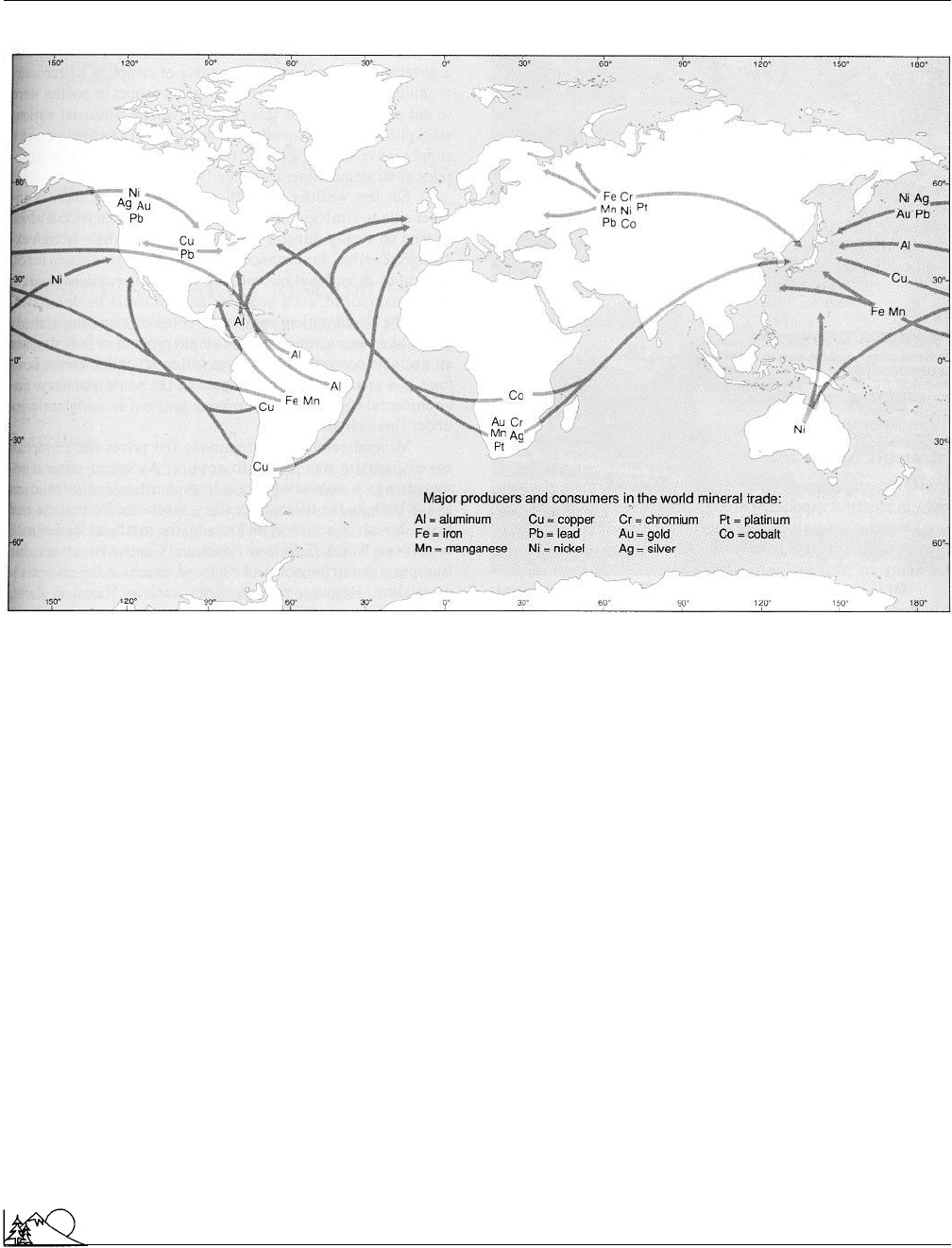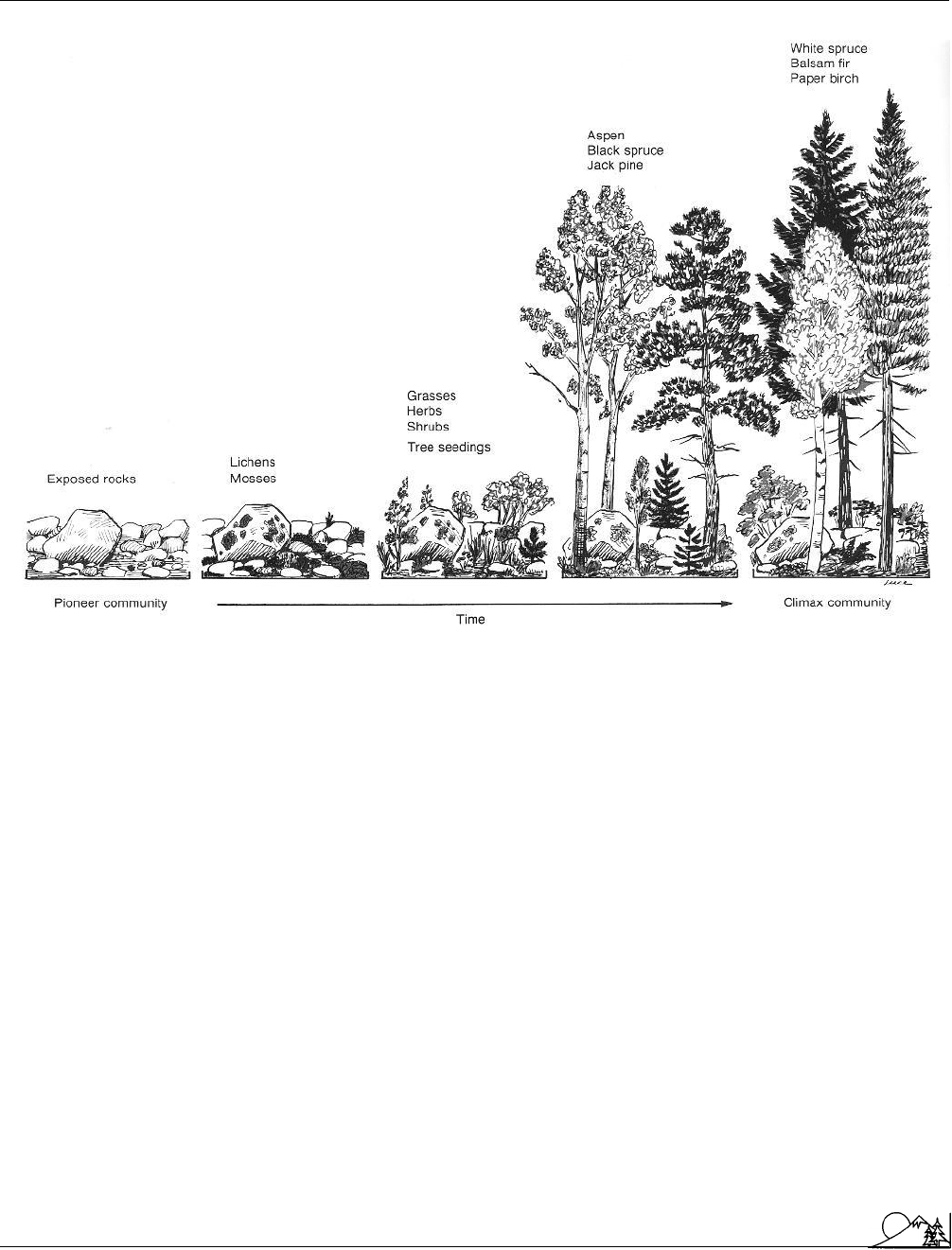Environmental Encyclopedia
Подождите немного. Документ загружается.


Environmental Encyclopedia 3
Strategic minerals
Global mineral trade. (McGraw-Hill Inc. Reproduced by permission.)
examples of strategic minerals are tin, silver, cobalt, manga-
nese, tungsten, zinc, titanium, platinum, chromium, bauxite,
and diamonds. The United States must import at least half
the amount of each of these minerals that it uses each year.
Ensuring a constant and dependable supply of strategic
minerals is a complex political problem. In some cases, the
minerals we need can be obtained from friendly nations
with whom we can negotiate relatively easily. Canada, for
example, supplies a large part of the
nickel
, columbium,
gallium, tantalum,
cadmium
, and cesium used by American
industry. Nickel may be obtained from Norway; cobalt and
antimony from Belgium; and fluorspar from Italy.
Other nations on whom we depend, however, are less
friendly, less dependable, or less stable. The southern African
nations of Zaire, Zambia, Zimbabwe, Botswana, and South
Africa, for example, are major suppliers of such strategic
minerals as chromium, gold, platinum, vanadium, manga-
nese, and diamonds. Africa also has large deposits of copper,
cobalt and chromium. When these nations experience politi-
cal unrest, supplies of these minerals may become scarce. A
report issued by the United States Agency for International
Development (USAID) in November 2000 underscored the
1347
point that ongoing American investment in Africa is neces-
sary because of our need for the continent’s strategic min-
erals.
Since 1980, the United States government has tried
to protect American industry, especially defense industries,
from the danger of running out of strategic minerals. Some
analysts have feared that political factors might result in
the loss of certain minerals that are needed by industry,
particularly those used in the manufacture of military hard-
ware. In 1984, the United States Congress established the
National Critical Materials Council (NCMC) to advise the
President on issues involving strategic minerals. The Council
monitored domestic and international needs and trends for
nearly a decade to ensure the nation’s access to a dependable
supply of strategic minerals. In 1993, the NCMC was placed
under the supervision of the newly established National Sci-
ence and Technology Council.
A similar monitoring function has been performed by
the Defense Logistics Agency (DLA), a division of the
Department of Defense dating back to World War II. The
DLA maintains and administers the Defense National
Stockpile Center, or DNSC, which sells and maintains stra-

Environmental Encyclopedia 3
Stratification
tegic and critical materials in order to reduce the country’s
dependence on foreign sources of supply. The DNSC is
presently located in Fort Belvoir, Virginia.
In addition to political unrest, however, the supply of
strategic minerals depends on humankind’s general manage-
ment of the earth’s
nonrenewable resources
. Of the min-
erals in common use in manufacturing and industry, 80 are
in abundant supply. There are, however, about 18 minerals
that are expected to be in short supply around the globe by
2015; these include gold, silver,
mercury
, lead, sulfur, tin,
tungsten, and zinc. It is estimated that the earth’s stores of
these minerals will be 80% depleted by 2040. Strategies for
lowering present levels of use in the developed nations in-
clude
recycling
; inventing new substitute materials and find-
ing new uses for old ones; decreasing the size of products;
and extending the lifespan of items made from strategic
minerals. A recent report to the Canadian government from
the assistant deputy minister for the minerals and metals
sector of
natural resources
stated that competition among
nations for strategic minerals has already begun to transform
the manufacturing processes used by Canadian industries as
of 2002.
[David E. Newton and Rebecca J. Frey Ph.D.]
R
ESOURCES
B
OOKS
Anderson, Ewan W., and Liam D. Anderson. Strategic Minerals: Resource
Geopolitics and Global Geo-Economics. New York: John Wiley and Sons,
1997.
Collins, John M. Military Geography for Professionals and the Public. Wash-
ington, DC: National Defense University Press, 2001.
Strategic Minerals: A Resource Crisis. Washington, DC: Council on Econom-
ics and National Security, 1981.
U.S. Bureau of Mines. The Domestic Supply of Critical Minerals. Washington,
DC: U S. Government Printing Office, 1983.
P
ERIODICALS
Homer-Dixon, Thomas F. “Environmental Scarcity, Mass Violence, and
the Limits to Ingenuity.” Current History 95 (November 1996): 359–365.
O
THER
Derryck, Vivian L. Remarks to the Foreign Service Association of Northern
California. Presentation given in San Francisco, CA, November 3, 2000.
Kelly, Thomas, David Buckingham, and Carl DiFrancesco, et al. Historical
Statistics for Mineral Commodities in the United States. United States Geolog-
ical Survey Open-File Report 01-006, June 2002.
Minerals and Metals Sector of Natural Resources Canada. Focus 2006:
A Strategic Vision for 2001–2006. Ottawa, Ontario: Public Works and
Government Services Canada, May 2002.
O
RGANIZATIONS
U.S. Department of the Interior, U.S. Geological Survey, Minerals
Information, 988 National Center, Reston, VA USA 20192 Toll Free: (888)
ASK-USGS (888-275-8747), Email: Contact person: Joseph Gambogi,
jgambogi@usgs.gov, www.minerals.usgs.gov/minerals/
1348
Stratification
The process by which a region is divided into relatively
distinct, nearly horizontal, layers. Sedimentary rock often
consists of various strata because the rock was laid at different
times when different materials were being deposited. Lakes
and oceans also consist of strata where plant and animal life
may be very different depending on the temperature and
amount of light available. The
atmosphere
is divided into
strata that differ in density, temperature, chemical composi-
tion, and other factors. In the lower atmosphere, temporary
stratification, such as temperature inversions, may occur,
often resulting in severe
pollution
conditions.
Stratosphere
A layer of the
atmosphere
that lies between about 7 and
31 mi (11 and 50 km) above the earth’s surface, bounded
at the bottom by the
tropopause
and at the top by the
stratopause. Scientists became aware of the presence of the
stratosphere with observations of high level dust after the
eruption of
Krakatoa
in 1883. However, the real discovery
of the stratosphere had to await Teisserenc de Bort’s work
of 1900.
The stratosphere is characterized by temperatures that
rise with height. As a result, the air is very stable, not mixing
much vertically, and allowing distinct layers of air, or strata,
to form. There are also persistent regular strong winds, of
which the best known are the intense western winds during
the winter called the polar night jet stream.
The air in the stratosphere has much the same compo-
sition as the lower atmosphere except for a higher proportion
of
ozone
.
Absorption
of incoming
solar energy
by this
ozone makes the upper parts of the stratosphere warm and
sets up the characteristic temperature gradient. The relatively
high ozone concentrations are maintained by photochemical
reactions. It has become clear in more recent years that other
chemical reactions involving
nitrogen
and
chlorine
are also
important in maintaining the ozone balance of the upper
atmosphere. This balance can be easily disturbed through
the input of additional
nitrogen oxides
and halogen com-
pounds (from CFCs, or
chlorofluorocarbons
). Transfer of
gases across the tropopause into the stratosphere is rather
slow, but some gases, such as CFCs and
nitrous oxide
, are
sufficiently long-lived in the
troposphere
to leak across
into the stratosphere and cause
ozone layer depletion
.
Large volcanic eruptions can have sufficient force to drive
gases and particles into the stratosphere where they can also
disturb the ozone balance. High-flying aircraft represent
another source of
pollution
in the stratosphere, but the lack
of development of a supersonic passenger fleet has meant
that this contribution has remained fairly small.

Environmental Encyclopedia 3
Stringfellow Acid Pits
The stratosphere is extremely cold (about −112°F
[−80°C]) in places, so there is relatively little water. Never-
theless, nacreous or mother-of-pearl clouds, although not
frequently observed, have long been known. More recently
there has been much interest in polar stratospheric clouds
which had hitherto received little attention. Stratospheric
cloud particles can be water-containing sulfuric
acid
droplets
or solid nitric acid hydrates. Studies of the Antarctic ozone
hole have revealed that these clouds are likely to play an
important role in the depletion of ozone in the polar strato-
sphere. See also Acid rain; Cloud chemistry; Ozonation;
Stratification; Volcano
[Peter Brimblecombe Ph.D.]
R
ESOURCES
B
OOKS
Chamberlain, J. W., and D. M. Hunten. Theory of Planetary Atmospheres.
New York: Academic Press, 1987.
Stray voltage
see
Electromagnetic field
Stream channelization
The process of straightening or redirecting natural streams
in an artificially modified or constructed stream bed. Chan-
nelization has been carried out for numerous reasons, most
often to drain
wetlands
, direct water flow for agricultural
use, and control
flooding
. While this process makes a stream
more useful for human activities, it tends to interfere with
natural river habitats and to destabilize stream banks by
destroying riparian vegetation. When annual flood patterns
are disrupted, fertilizing
sediment
is no longer deposited
on river banks and excessive sediment accumulation can
occur downstream. Perhaps most importantly, wetland
drainage
and the removal of instream obstacles such as
rocks, fallen trees, shallow backwaters, and sand bars elimi-
nate feeding and reproductive habitats for fish, aquatic in-
sects, and birds.
Stringfellow Acid Pits
Aerospace, electronics, and other high-technology busi-
nesses expanded rapidly in California during the 1950s,
bringing
population growth
and rapid economic progress.
These businesses also brought a huge volume of toxic wastes
and the problem of safely disposing of them. A modern-
day reminder of those years is the Stringfellow Acid Pits
1349
located near the Riverside suburb of Glen Avon, 50 mi (80
km) east of Los Angeles.
The Acid Pits, also known as the Stringfellow Quarry
Waste Pits, are located on a 20-acre (8-ha) site in Pyrite
Canyon above Glen Avon. In the mid-1950s, a number of
high-tech companies began to dump their hazardous wastes
into the canyon. No special precautions were taken in the
dumping process; as one observer noted, the companies got
rid of their wastes just as cavemen did: “They dug a hole
and dumped it in.”
Over the next two decades, more than 34 million gal
(129 million L) of waste were disposed of in a series of pan-
shaped reservoirs dug into the canyon floor. The wastes
came from more than a dozen of the nation’s most prominent
companies, including McDonnell-Douglas, Montrose
Chemical, General Electric, Hughes Aircraft, Sunkist
Growers, Philco-Ford, Northrop, and Rockwell-Interna-
tional. The wastes consisted of a complex mixture of more
than 200 hazardous
chemicals
. These included hydrochlo-
ric, sulfuric, and nitric acids; sodium hydroxide; trichlorethy-
lene and methylene chloride;
polychlorinated biphenyls
(PCBs); a variety of pesticides; volatile organic compounds
(VOCs); and
heavy metals
such as
lead
,
nickel
,
cadmium
,
chromium, and manganese.
By 1972, residents of Glen Avon had begun to com-
plain about health effects caused by the wastes in the
Stringfellow Pits. They claimed that some chemicals were
evaporating and polluting the town’s air, while other chemi-
cals were
leaching
out of the dump and contaminating the
town’s
drinking-water supply
. People attributed health
problems to chemicals escaping from the dump; these prob-
lems ranged from nose bleeds, emotional distress, and in-
somnia to
cancer
and genetic defects. Medical studies were
unable to confirm these complaints, but residents continued
to insist that these problems did exist.
In November 1972, James Stringfellow, owner of the
pits, announced that he was shutting them down. However,
his decision did not solve the problem of what to do with
the wastes still in the pit. Stringfellow claimed his company
was without assets, and the state of California had to take
over responsibility for maintaining the site.
The situation at Stringfellow continued to deteriorate
under state management. During a March 1978 rainstorm,
the pits became so badly flooded that officials doubted the
ability of the existing
dams
to hold back more than 8 million
gal (30.3 million L) of wastes. To prevent a possible disaster,
they released nearly 1 million gal (3,785 million L) of liquid
wastes into flood control channels running through Glen
Avon. Children in nearby schools and neighborhoods, not
knowing what the brown water contained, waded and played
in the toxic wastes.

Environmental Encyclopedia 3
Strip-farming
When the
Comprehensive Environmental Re-
sponse, Compensation and Liability Act
(Superfund) was
passed in 1980, the Stringfellow Pits were named the most
polluted waste site in California. The pits became one of first
targets for
remediation
by the
Environmental Protection
Agency
(EPA), but this effort collapsed in the wake of a
scandal that rocked both the EPA and the Reagan adminis-
tration in 1983. EPA administrators Rita Lavelle and Anne
McGill Burford were found guilty of mishandling the Su-
perfund program, and were forced to resign from office along
with 22 other officials.
During the early 1990s, citizens of Glen Avon finally
began to experience some success in their battle to clean up
the pits. The EPA had finally begun its remediation efforts
in earnest, and residents won judgments of more then $34
million against Stringfellow and four companies that had
used the site. In 1993, residents initiated the largest single
civil suit over toxic wastes in history. The suit involved 4,000
plaintiffs from Glen Avon and 13 defendants, including the
state of California, Riverside County, and a number of major
companies. See also Contaminated soil; Groundwater pollu-
tion; Hazardous waste site remediation; Hazardous waste
siting; Storage and transport of hazardous materials
[David E. Newton]
R
ESOURCES
B
OOKS
Brown, M. H. Laying Waste: The Poisoning of America by Toxic Chemicals.
New York: Pantheon Books, 1980.
P
ERIODICALS
Gorman, T. “A Tainted Legacy: Toxic Dump Site in Riverside County
Has Sparked the Nation’s Largest Civil Suit.” Los Angeles Times (January
10, 1993): A3.
Madigan, N. “Largest-Ever Toxic-Waste Suit Opens in California.” New
York Times (February 5, 1993): B16.
Mydans, S. “Settlements Reached on Toxic Dump in California.” New
York Times (December 24, 1991): A11.
Strip-farming
In the United States,
soil conservation
first became an
important political issue in the 1930s, when President Frank-
lin D. Roosevelt led a campaign to study the loss of valuable
topsoil
because of
erosion
. It soon became clear that one
source of the problem was the fact that farmers tended to
plow and plant their fields according to property lines, which
usually formed squares or rectangles. As a result, furrows
often ran up and down the slope of a hill, forming a natural
channel for the
runoff
of rain, and each new storm would
wash away more fertile topsoil. This kind of erosion resulted
1350
not only in the loss of
soil
, but also in the
pollution
of
nearby waterways.
The
Soil Conservation Service
was founded in 1935
as a division of the
U.S. Department of Agriculture
, and
one of its goals was the development of farming techniques
that would reduce the loss of soil. One such technique was
strip-farming, also known as strip-cropping. Strip-farming
involves the planting of crops in rows across the slope of
the land at right angles to it rather than parallel to it. On
gently sloping land, soil
conservation
can be achieved by
plowing and planting in lines that simply follow along the
slope of the land rather than cutting across it, a technique
known as
contour plowing
. On very steep slopes, a more
aggressive technique known as
terracing
is used. Strip-
farming is a middle point between these two extremes, and
it is used on land with intermediate slopes.
In strip-farming, two different kinds of crops are
planted in alternate rows. One set of rows consists of crops
in which individual plants can be relatively widely spaced,
such as corn, soybeans, cotton, or sugar beets. The second
set of rows contains plants that grow very close together,
such as alfalfa, hay, wheat, or legumes. As a result of this
system, water is channeled along the contour of the land,
not down its slope. In addition, the closely planted crops in
one row protect the exposed soil in the more widely spaced
crops in the second row. Crops such as alfalfa also slow
down the movement of water through the field, allowing it
to be absorbed by the soil.
The precise design of a strip farm is determined by a
number of factors, such as the length and steepness of the
slope. The crops used in the strip, as well as the width of
rows, can be adjusted to achieve minimal loss of soil. Under
the most favorable conditions, soil erosion can be reduced
by as much as 75% through the use of this technique. See
also Agricultural pollution; Agricultural technology; Soil
compaction; Soil loss tolerance
[Lawrence H. Smith]
R
ESOURCES
B
OOKS
Enger, E. D., et al. Environmental Science: The Study of Relationships. 2nd
ed. Dubuque, IA: W. C. Brown, 1986.
Moran, J. M., M. D. Morgan, and J. H. Wiersma. Introduction to Environ-
mental Science. 2nd ed. New York: W. H. Freeman, 1986.
Petulla, J. M. American Environmental History. San Francisco: Boyd &
Fraser, 1977.
Strip mining
This technique is used for near-surface, relatively flat sedi-
mentary mineral deposits. How deeply the mining can occur

Environmental Encyclopedia 3
Strip mining
is essentially determined by the combination of technological
capabilities and the economics involved. The latter includes
the current value of the mineral, contractual arrangements
with the landowner, and mining costs, including
reclama-
tion
. Strip mining is used for mining phosphate
fertilizer
in Florida, North Carolina, and Idaho, and for obtaining
gypsum (mainly for wallboard) in western states.
However, the most common association of strip min-
ing is with
coal
. The examples of decimated land in Appala-
chia have motivated calls for prevention, or at least major
efforts at reclamation. Strip mining for coal comprises well
over half of the land that is strip-mined, which totaled less
that 0.3% of land in the United States between 1930 and
1990. This is far less land than the amount lost to agriculture
and urbanization. However, in agriculturally rich areas like
Illinois and Indiana there is a growing concern over the one-
time disruption of land for mineral extraction, compared to
the long term use for food production.
Strip mining has occurred mainly in the Appalachian
Mountains and adjacent areas, the Central Plains from Indi-
ana and Illinois through Oklahoma, and new mines for
subbituminous coal in North Dakota, Wyoming, and Mon-
tana. Important mining is also carried out on Hopi and
Navajo lands, notably Black Mesa in northeastern Arizona.
Despite the small amount of land used in strip mining,
the process radically alters landforms and ecosystems where
it is practiced. Depending on state laws, mining landscapes
prior to 1977 were often left as is, dubbed “orphan lands.”
The 1977 act required the land to be restored as closely as
possible to the original condition. This is a nearly impossible
task, especially when one considers the reconstruction of
the preexisting
soil
conditions and
ecosystem
. Even so,
reclamation is a vital first step in the healing process. Gener-
ally, the steeper the terrain, the greater the impact on the
landforms and river systems, and the more difficult the recla-
mation.
Detailed economic planning precedes any strip mining
effort. Numerous cores are drilled to determine the depth,
thickness, and quality of the coal, and to assess the difficulty
of removing the
overburden
, which consists of
topsoil
and
rock above the resource. If caprock is encountered, expensive
and time-consuming blasting is required, a frequent occur-
rence in the United States. Economic analysis then deter-
mines the area and depth of profitable overburden removal.
Finally, contracts must be negotiated with landowners; strip
mines commonly end abruptly at property lines.
Two kinds of earth removal equipment are typically
used: a front-loading bucket (the classic steam shovel), or a
dragline bucket that pulls the material toward the operator.
Power shovels and draglines built prior to World War II
generally have bucket capacities of 30–50 yd
3
(23–38 m
3
).
Post-World-War-II equipment may have a capacity up to
1351
200 yd
3
(153 m
3
). A new development, encouraged by the
1977 reclamation law, is the combination of dozers and
scrapers (belly loaders) more commonly seen on road-build-
ing or construction sites.
After the overburden is removed, mining begins. The
process is conducted in rows, creating long ridges and valleys
in the countryside that resemble a washboard. Coal extrac-
tion follows behind power shovels, leaving a flat, canyon-
like cut. Upon completion of a row, the shovel starts back
in the opposite direction, placing the new overburden in the
now-empty cut.
In hilly terrain, only a few cuts are all that is usually
profitable because the depth of overburden increases rapidly
into the hillside. Since the worst complications as a result
of strip mining occur on hillsides, the environmental price
for a limited amount of coal is very high. Hillside mining
such as this is called “contour mining,” in contrast to “area
mining” on relatively flat terrain. In the latter, the number
of rows are limited mostly by contractual arrangements.
Consequently, the main difference between area and contour
strip mining are the number of rows and the steepness of
the terrain.
Both types of strip mining leave behind four basic land
configurations: l)
spoil
bank ridges; 2) a final-cut canyon
often partially filled by a lake; 3) a high headwall marking
the uphill end of the mining; and 4) coal-haul roads, usually
at the base of the outermost spoil bank and through gaps
in the spoil-bank rows left for this purpose. In some orphan
lands, wilderness-like conditions prevail, where trees popu-
late the spoil banks and aquatic ecosystems thrive in the
final-cut lake. Left alone by man, these may afford a surpris-
ingly rich
habitat
for
wildlife
, especially birds. Deer thrive
in some North Dakota abandoned mines.
Reclamation of area mining is relatively simple com-
pared to contour strip mining. Prior to mining, the topsoil
is removed and stockpiled. The overburden from the initial
cut may be used to fill in the final cut, and the top part of
the headwall is sometimes cut down to grade into the spoil.
The spoil banks are leveled and the topsoil replaced; fertiliza-
tion and replanting, usually with grasses or trees for
erosion
control, and subsequent monitoring of revegetation efforts,
complete the process. In large operations, the leveling and
replanting coincide with mining, which is ideal since this
rapidly rebuilds the vegetation cover.
Reclamation of contour mining presents far greater
difficulties, primarily because of the slope angles encoun-
tered. Research in Great Britain revealed that even well-
vegetated slopes were producing 50 to 200 times as much
sediment
as similar, undisturbed slopes. Furthermore, the
greater slope angles allow much more of the sediment to
reach the channel below, where it eventually flows into
streams and rivers.

Environmental Encyclopedia 3
Strontium 90
Another problem for orphan lands in hilly terrain is
the ecological island left when hills are completely enclosed
by high headwalls. This is not unlike the ecological islands
created in the southwestern United States from
climate
changes and vertical zonation of vegetation. Though far
more recent, ecologists hope these “orphan islands” will allow
interesting case studies of genetic isolation.
The long-term effect of strip mining has been the
subject of research in Kentucky, Indiana, and Oklahoma.
For over a decade the United States
Geological Survey
studied Beaver Creek Basin, Kentucky, obtaining valuable
data before and after contour mining. Their findings were
published in a 1970 report authorized by C.R. Collier and
others. As expected, mining left a degraded landscape, and
resulted in much greater
runoff
, sediment production, and
water quality
problems. By contrast, area mining in Indiana
trapped vast quantities of
groundwater
within the loosened
soil, reducing peak discharges, extending base flow, and
yielding water of acceptable quality.
In Oklahoma, a study conducted by Nathan Meleen
dealt with a mix of both flat and hilly terrain. The findings
were published as a doctoral dissertation in 1977 by Clark
University. Area mining, Meleen found, produced far more
benign impacts than did contour stripping. The worst condi-
tions were encountered where contour mining was adjacent
to streams below, especially around the end of ridges. The
short distances and relatively steep gradients gave ideal condi-
tions for sediment and
acid drainage
into the channels be-
low. Summer runoff decreased while winter runoff increased.
The huge holes left by these unreclaimed operations acted
like reservoirs during the drier summer months, but in winter
when wetter conditions prevailed, they yielded more outflow
than before mining, because of altered
infiltration
rates.
Strangely enough, a 1971 Oklahoma law produced
effects similar to what the Geological Survey found in Ken-
tucky. The incomplete reclamation and lack of sediment
retention or topsoil replacement created ideal erosion condi-
tions, with rates approaching 13% sediment by weight. This
focuses the crucial role of topsoil replacement and rapid
revegetation as the preeminent needs in reclamation. Efforts
to revegetate some orphan lands where topsoil replacement
is impossible will only result in worse conditions, especially
downstream. Given the fact that most impacts from area
mining are retained onsite, and that orphan lands possess
great potential for
recreation
, especially fishing and hiking,
at least some should be left undisturbed. See also High-
grading; Mine spoil waste; Surface mining
[Nathan H. Meleen]
R
ESOURCES
B
OOKS
Caudill, H. M. Night Comes to the Cumberlands. Boston: Atlantic-Little,
Brown, 1963.
1352
Collier, C. R., et al. Influences of Strip Mining on the Hydrologic Environment
of Parts of Beaver Creek Basin, Kentucky, 1955-66. USGS Professional Paper
427-C. Washington, DC: U. S. Government Printing Office, 1970.
Doyle, W. S. Strip Mining of Coal: Environmental Solutions. Park Ridge,
NJ: Noyes Data Corp., 1976.
Landy, M. K. The Politics of Environmental Reform: Controlling Kentucky
Strip Mining. Baltimore: Johns Hopkins University Press, 1976.
O
THER
U.S. Department of the Interior. “Surface Mining and Our Environment:
A Special Report to the Nation.” Washington, DC: U. S. Government
Printing Office, 1967.
U.S. Environmental Protection Agency. “Erosion and Sediment Control:
Surface Mining in the Eastern U.S.: Planning.” Washington, DC: U. S.
Government Printing Office, 1976.
Strix occidentalis caurina
see
Northern spotted owl
Strontium 90
A radioactive
isotope
of strontium, produced during
nu-
clear fission
. The isotope was of great concern to environ-
mental scientists during the period of atmospheric testing
of
nuclear weapons
. Strontium 90 released in these tests
fell to the Earth’s surface, adhered to grass and other green
plants, and was eaten by cows and other animals. Since
strontium is chemically similar to calcium, it follows the
same metabolic pathways, ending up in an animal’s milk.
When a child drinks this milk, strontium 90 becomes incor-
porated into their bones and teeth. With a
half-life
of about
28 years, strontium 90 continues to emit radiation through-
out the individual’s lifetime.
Student Environmental Action
Coalition
Founded in 1990, the Student Environmental Action Coali-
tion (SEAC) focuses on social justice and on environmental
and political issues throughout the United States. The mis-
sion of SEAC is to unite youth that have exhibited leadership
in their community and to create an environmental move-
ment. It has activists that build allegiances among local,
regional, national, and international communities engaged
in environmental struggles.
The unique aspect of SEAC membership is that there
is not a national office that dictates an agenda to the local
groups. Instead, local groups coordinate a National Council
each year to run SEAC. The local groups are composed of
schools or neighborhood clubs, with each choosing its own
problem areas to focus on. Some topics that are frequently

Environmental Encyclopedia 3
Submerged aquatic vegetation
addressed include combating racism and sexism, and devel-
oping a sustainable living style.
Skills in each local group are developed at conferences
held throughout the year. These conferences are led by stu-
dents and consist of workshops on the strategies, lectures,
and publicity for grassroots organizing.
In 1998, SEAC was forced to cut one of its key funding
programs which proved disastrous for the group. Fortu-
nately, they were able to reopen, although with a much
smaller staff and reduction of size and publication of its
magazine, Threshold. Now that SEAC relies primarily on
donations and membership dues, the group has continued
to expand and work on projects such as the Clean Energy
Campaign.
[Nicole Beatty]
R
ESOURCES
O
RGANIZATIONS
Student Environmental Action Coalition, P.O. Box 31909, Philadelphia,
PA USA 19104-0609 (215) 222-4711, Fax: (215) 222-2896, Email:
seac@seac.org, <http://www.seac.org>
Styrene
Styrene is an oily organic liquid with an aromatic odor that
is used as a building block for polymers in the manufacture
of
plastics
, resins, coatings, and paints. Short-term health
effects of styrene exposure include nervous system effects
such as depression, loss of concentration, weakness, fatigue,
and nausea. Potential long-term effects include liver and
nerve tissue damage. Styrene has been designated as a possi-
ble human
carcinogen
. The drinking water standard (Maxi-
mum Contaminant Level, or MCL) for styrene is 0.1
parts
per million
(ppm). Styrene when released into water rapidly
evaporates or is degraded by
microorganisms
. It does not
bind to soils and may leach to ground water. However, its
rapid degradation minimizes its
leaching
potential. Styrene
does not tend to accumulate in aquatic life. It is also found
in the air and in the microgram/cubic meter range.
[Judith L. Sims]
R
ESOURCES
O
THER
U.S. Environmental Protection Agency. Consumer Factsheet on: Styrene.
May 22, 2002 [cited June 23, 2002]. <http://www.epa.gov/safewater/dwh/
c-voc/styrene902.html>.
O
RGANIZATIONS
The Styrene Information and Research Center, 1300 Wilson Boulevard,
Suite 1200, Arlington, Virginia USA 22209, (703) 741-5010, Fax: (703)
741-6010), <http://www.styrene.org>
1353
Subbituminous coal
see
Coal
Submerged aquatic vegetation
Submerged aquatic vegetation consists of a taxonomically
diverse group of plants that lives entirely beneath the water
surface. This diverse group of aquatic plants includes
species
of angiosperm vascular plants, mosses, and liverworts, and
macroalgae (seaweeds). Their underwater growth habit sepa-
rates them from other kinds of aquatic plants that are free-
floating, have floating leaves, or are emergent above the
water surface.
Almost all species of submerged aquatic plants live in
freshwater ponds, lakes, rivers, streams, and
wetlands
, and
shallow marine waters. They can occur in ponds with an
acidic
pH
less than 4 or in alkaline waterbodies with pH
greater than 10, but they tend to be most rich in species at
pHs of 6 to 8. Only a few angiosperm species occur in
brackish
estuarine or marine habitats, including the
eel-
grass
(Zostera marina), widgeon grass (Ruppia maritima),
and turtle-grasses (Thalassia species). No aquatic mosses or
bryophytes occur in saline waters.
Macroalgae, commonly known as seaweeds, are also
classified as submerged aquatic vegetation though they are
not biologically part of the kingdom Plantae. They are mem-
bers of the kingdom Protista and live within the marine
environment
. They, too, are beneficial to the aquatic
habitat
.
Both grasses and macroalgae absorb nutrients which
can be a source of pollutants in aquatic habitats. Submerged
vegetation also is a major food source for many different
species of organisms including waterfowl,
sea turtles
, and
manatees
. These plants and seaweeds add oxygen to the
water, and grass roots help stabilize shorelines against
ero-
sion
. Additionally, submerged aquatic vegetation provides
shelter and food for organisms. For example, crustaceans,
especially the blue crab, and juvenile or larval fish use sub-
merged vegetation as protective nurseries and a means to
hide from predators. Some organisms like barnacles and
bryozoans attach themselves to plant surfaces to live. Other
species use submerged vegetation as place to lay eggs and
hatch new offspring.
Though communities of submerged aquatic vegetation
help improve
water quality
, their own survival depends on
maintaining good water quality. These plants and macroal-
gae are sensitive to environmental changes brought about
by agricultural
runoff
, industrial waste, and global warming.
Increased temperature,
salinity
, and depth of coastal waters
in particular can contribute to marked habitat change for

Environmental Encyclopedia 3
Subsidence
these species, thus threatening their distribution and abun-
dance.
Submerged aquatic plants are most abundant in rela-
tively shallow water, where they have access to enough sun-
light to engage in
photosynthesis
at a high enough rate to
survive. Waterbodies with poor
visibility
may support few
or no submerged aquatic plants, and only at very shallow
depths. Waterbodies may have poor visibility because of an
excessive abundance of
phytoplankton
, or they may be
highly turbid because of suspended clays, or they may be
brown-colored because of dissolved organic matter leached
from nearby bogs or peaty
soil
. Waterbodies with exception-
ally clear water may have submerged aquatic plants growing
on the bottom as deep as about 19 feet (6 m). Shallow,
moderately fertile, mesotrophic or eutrophic waterbodies
may support especially large populations of submerged
aquatic plants, where they may even be regarded as nuisance
“weeds”.
Some of the most widespread and familiar species of
angiosperm submerged aquatic plants include the tape-grass
or wild celery (Vallisneria americana), the waterweed (Elodea
canadensis), the ribbon-leaf pondweed (Potamogeton epi-
hydris), the slender water-nymph (Najas gracillima), the pi-
pewort (Eriocaulon septangulare), the greater bladderwort
(Utricularia vulgaris), and the lake quillwort (Isoetes lacustris).
Examples of bryophytes that are submerged aquatic plants
include an aquatic peatmoss (Sphagnum macrophyllum), an
aquatic moss (Fontinalis antipyretica), and an aquatic liver-
wort (Ricciocarpus natans).
A few species of submerged aquatic plants are used as
ornamentals in aquaria and outdoor water-gardens. There
are even some clubs of aficionados of the aesthetics of these
cultivated aquatic plants. Examples include the Amazon
sword (Echinodorus amazonicus), the tropical hornwort
(Ceratophyllum submersum), the temple plant (Hygrophila cor-
ymbosa), the Java moss (Vesicularia dubyana), and a tropical
aquatic liverwort (Riccia fluitans). Submerged aquatic plants
are also used as
ecosystem
components in the constructed
wetlands that are sometimes used to treat human sewage
and other wastes.
A few submerged aquatic plants, particularly several
non-native invasive species, can be sufficiently abundant that
they are considered serious weeds because of their effects on
the use of waterbodies for
recreation
and
transportation
.
Some of the most important invasive weeds of this kind in
North America are the Eurasian water-milfoil (Myriophyllum
spicatum), the Brazilian waterweed (Egeria densa), and the
hydrilla (Hydrilla verticillata). Attempts are sometimes made
to reduce infestations of these species using mechanical har-
vesters or herbicides.
[Bill Freedman Ph.D.]
1354
R
ESOURCES
B
OOKS
Borman, S., R. Korth, and J. Temte. Through the Looking Glass: A Field
Guide to Aquatic Plants. Madison, WI: University of Wisconsin Press, 1997.
Crow, G. E. and C. B. Hellquist. Aquatic and Wetland Plants of Northeastern
North America. Madison, WI: The University of Wisconsin Press, 2000.
Fassett. N. C. A Manual of Aquatic Plants. Madison, WI: University of
Wisconsin Press, 1957.
Subsidence
To subside is to sink or fall. Subsidence is commonly associ-
ated with the lowering of the earth’s surface due to actions
that have occurred below the surface. Sometimes this is a
natural phenomenon, such as the solubilizing and removal
of minerals by water. When the underground support system
is removed in the process, the surface of the land sinks to
a new level. This often leads to a special topographic form
known as Karst
topography
. Human activities that lead to
the extraction of ores, minerals, and
fossil fuels
often lead
to a weakened mineral structural support and subsidence of
the surface of the earth. In the
arid
portions of the earth,
extraction of water from sub-surface aquifers has led to subsi-
dence of the earth’s surface as well.
Subsoil
The portion of the
soil
that is below the surface. The subsoil
is often referred to as the B
horizon
. Subsoils are generally
lower in organic matter, lighter in color, denser, and often
have a higher clay content than surface soils. Subsoils are
generally not as productive as surface soils for plant growth.
Thus, if surface soils are eroded, future productivity is re-
duced when the subsoil is used for crop production.
Succession
Succession is the gradual transformation or creation of a
biological community
as new
species
move into an area
and modify local environmental conditions. Primary succes-
sion occurs when plant and animal species colonize a pre-
viously barren area, such as a new volcanic island, a sand
dune, or recently glaciated ground. In these cases every living
thing, from
soil
bacteria and
fungi
to larger plants and
animals, must arrive from some adjacent
habitat
. Secondary
succession is the development of communities in an area
that has been disturbed by fire, hurricanes, field clearing,
tree felling, or some other process that removes most plants
and animals. Intermediate successional communities are
known as “seral stages” or “seres.”

Environmental Encyclopedia 3
Succession
As early successional species become established, they
alter their
environment
and make it more habitable for
later seral stages. Usually a disturbed or barren area has low
soil
nutrient
levels, intense sunlight, and no protection from
violent weather. Because precipitation quickly runs off the
bare ground, little moisture is available for plant growth.
Species that can survive under such harsh conditions have
little
competition
, and they spread quickly. As they grow
and thicken, these plants add organic matter to the soil,
which aids moisture retention and helps soil bacteria to grow.
As soil nutrients and moisture increase, larger shrubs and
perennial plants can take root. The shade of these larger
species weakens and eventually eliminates the original pion-
eering species, but it cools the local environment, further
improving moisture availability and allowing species that
demand relative environmental
stability
, such as woodland
species, to begin moving in. Eventually, shade-tolerant spe-
cies of plants will come to dominate the area that sun-loving
plants had first colonized.
One of the most well-documented examples of pri-
mary succession occurred in 1883 when the
volcano
on the
Indonesian island of
Krakatoa
erupted, destroying most of
the island and its life forms, and leaving a new island of
bare volcanic rock and ash. Within a few years several species
of grasses, ferns, and flowering shrubs had managed to arrive,
carried by wind, water, or passing birds from islands 25 mi
(40 km) or more distant. Just 40 years later, more than 300
plant species were growing, and in some areas over 12 in
(30 cm) of soil had developed: soil bacteria, insects, and
decomposers
had managed to reach the island and were
turning fallen organic
detritus
into soil. Over the decades,
the total number of species gradually stabilized, but the
character of the community continued to change as incoming
species replaced earlier arrivals. On Krakatoa succession hap-
pened with unusual speed because the
climate
is warm and
humid and because the fresh volcanic ash made a nutrient-
rich soil.
Early successional species, those most able to quickly
establish a foothold, are known as pioneer species. Usually
pioneer species are opportunists, able to find nourishment
and survive under a great variety of conditions, quick to grow,
and able to produce a great number of seeds or offspring at
once. Pioneer species have very effective means of dispersing
seeds or young, and their seeds can often remain dormant
in soil for some time, sprouting only after conditions become
suitable. Dandelions are well-known pioneers because they
can quickly produce a seed head with hundreds of seeds.
Each tiny seed has a lightweight structure that allows the
wind to carry it long distances. Dandelions are quick to
invade a lawn because of this effective seed-dispersal tactic,
because they can survive under sunny or shady conditions,
and because they grow and reproduce quickly. In open sun-
1355
shine, they are competitive enough to establish themselves
despite the presence of a thick mat of turf grass.
Later successional species tend to be more shade toler-
ant, slower to grow and reproduce, and longer lived than
pioneer species. Their larger seeds do not disperse as easily
(compare the size of an acorn or walnut with that of a
dandelion seed), and their seeds cannot remain dormant for
very long before they lose viability. Seedlings of some late
successional species, such as the Pacific Northwest hemlock,
require shade to survive, and most require considerable mois-
ture and soil nutrients.
We usually think of succession occurring after a cata-
strophic environmental disturbance, but in some cases the
gradual environmental changes of succession proceed in the
absence of disturbance. Two outstanding examples of this
are bog succession and the invasion of prairies by shrubs
and trees.
In cool, moist, temperate climates, plant succession
often turns ponds into forest through bog succession. Water-
loving plants, mainly rush-like sedges and sphagnum moss,
gradually creep out from the pond’s edges. Often these plants
form a floating mat of living and dead vegetation. Other
plants—cranberries, Labrador tea, bog rosemary—become
established on top of the mat. Organic detritus accumulates
below the mat. Eventually the bog becomes firm enough to
support black spruce, tamarack, and other tree species. As
it fills in and dries, the former pond slowly becomes indistin-
guishable from the surrounding forest.
Many
grasslands
persist only in the presence of occa-
sional wildfires. During wet decades or when human activity
prevents fires, woody species tend to creep in from the edges
of a
prairie
. If sufficient moisture is available and if fires
do not return, open grassland can give way to forest. Fire
suppression has aided the advance of forests in this way
across much of the United States, Canada, and Mexico.
Grazing or browsing animals can also be important forces
in maintaining biological communities. Adding or removing
grazers can initiate successional processes.
Longer, slower disturbances than fire or field clearing
can also initiate succession. Over the course of centuries,
climate change can cause significant alteration in the charac-
ter of biomes. Minor variations in rainfall or temperature
ranges can alter community structure for decades or centu-
ries. The end of the last glacial period about 10,000 years
ago allowed
tundra
, then grasslands, then temperate forests
to advance northward across North America. Even geologic
activity, such as mountain building or changes in sea level,
has caused succession. More recently, human introductions
of species from one continent to another have caused signifi-
cant restructuring of some biological communities.
Turnover from one community to another may occur
in just a few years or decades, as it did on Krakatoa. Stages

Environmental Encyclopedia 3
Succession
Five stages of primary succession on a terrestrial site. (McGraw-Hill Inc. Reproduced by permission.)
in bog succession may take a hundred years or more. Often,
succession continues for centuries or millennia before a stable
and relatively constant biological community emerges. This
is especially likely in areas whose climate is moist and mild
enough to support the high species diversity of temperate
or
tropical rain forests
. However, simpler ecosystems such
as arctic tundra may take centuries to recover from distur-
bance because low temperatures and short summers make
growth rates almost universally slow.
Generally, successional processes are understood to
lead ultimately to the emergence of a
climax
community,
a group of species perfectly suited to a region’s climate, soil
types, and other environmental conditions. Climax commu-
nities are said to exist in equilibrium in their environments;
where early successional species groups tend to facilitate the
development of later stages, climax communities, sometimes
called mature communities, tend to have self-perpetuating
characteristics or mechanisms that help maintain local envi-
ronmental conditions and help the community to persist. In
the 1930s, F. E. Clements, one of the best-known plant
ecologists in the United States, identified a list of just 14
climax communities that he claimed were the final result of
1356
succession for all the various sets of environmental conditions
in the country.
More recent evaluations of climax communities, how-
ever, have concluded that climax forests are often a patch-
work of stable and unstable areas. In an
old-growth forest
in the Pacific Northwest, hemlock and spruce may compose
the local climax community, but every time a large tree falls,
it creates a sunny opening that makes way for other seral
species to grow for a time. Occasional fires disturb larger
patches of forest, and succession starts again from the begin-
ning in disturbed areas. The entire
biome
is more a shifting
and changing mosaic than a uniform and unchanging forest.
Often, slight gradations in soil types, slope, exposure, and
moisture cause a variety of stable communities to blend in
an area. The term “polyclimax community” was developed
to recognize the complexity of such assemblages.
In some cases, climax communities may be difficult
to distinguish at all. For instance, in a biome regularly dis-
turbed by fire, “climax” species usually require fire to aid
seed germination and eliminate competitors. Definitions
here become somewhat blurred: Is a climax community one
